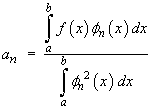ENGI 5432 Advanced Calculus
Faculty of Engineering and Applied Science2009 Winter
Problem Set 8 - Questions
[Sections 1.7, 2.6, 3]A point charge Q at the origin gives rise to the electrostatic potential field

- the potential V at the point (x, y, z ) = (3, -4, 12).
- the electric field vector E at the point (x, y, z ) = (3, -4, 12).
- the volume charge density
rV at the point
(x, y, z ) =
(3, -4, 12).
[Hint: use Poisson’s equation div D = rV .] - the magnitude Q of the point charge at the origin.
In spherical polar coordinates, the scalar field V is defined by
V(x, y, z) = r cos2q . - The vector field F is defined by F = ÑV . Find F.
- Find the divergence of F.
- Find the curl of F.
For the scalar field

- Find ÑV in the Cartesian coordinate system.
- Find the Laplacian Ñ2V in the Cartesian coordinate system in simplified form.
- Convert V(x, y, z) to spherical polar coordinates.
- Find ÑV in the spherical polar coordinate system in simplified form.
- Show that the Laplacian
Ñ2V
in the spherical polar coordinate system is
cot q. - Hence show that the value of the Laplacian of V is the same in both coordinate systems (except possibly on the z-axis).
A set of functions {fn(x) } is said to be orthonormal on the interval
(a, b) if

Show that { sin npx }, { cos npx } are both orthonormal on the interval(-1, 1). [Note: It then follows that if
 then
then
 which leads to methods of series solution of
differential equations, including Fourier series.]
which leads to methods of series solution of
differential equations, including Fourier series.]
Find the Fourier series for the function f (x) defined on the interval
[–1, 1] by
Find the Fourier series for the function f (x) defined on the interval
[–1, 1] by
Find the Fourier cosine series for the function f (x) defined on the interval
[0, 2] by
Find the Fourier sine series for the function f (x) defined on the interval
[0, 2] by
Also comment on why the rate of convergence of this Fourier series everywhere in the interval
[0, 2] is much more rapid than in question 7.
[A more challenging question:]
An incompressible viscous fluid is in steady-state flow around the z-axis, trapped between a pair of coaxial rotating cylinders, aligned along the z-axis. The inner cylinder has radius a and rotates at angular velocity w k. The outer cylinder has radius b (> a) and rotates at angular velocity u k.
In response, the velocity vector at any point in the fluid, in cylindrical polar coordinates(r, f, z), is and v(r)
obeys the ordinary differential equation
and v(r)
obeys the ordinary differential equation

Where it is in contact with a cylinder, the fluid must move with the same velocity as that cylinder.
Solve the ODE to find the velocity at all points in the fluid.
| [Solutions to this problem set]
|
|||